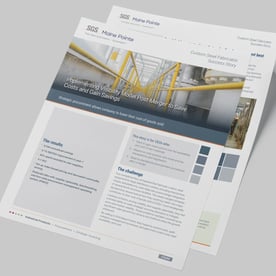Implementing Visibility Model Post-Merger to Save Costs and Gain Savings (CS280)

This story is for CEOs who
- Want to gain more control over the availability and cost of raw materials
- Depend on sole sources who resist pricing transparency and negotiation
- Need to standardize procurement procedures after a merger
The Challenges
Two complementary companies that fabricate custom steel equipment for large distribution centers, including mezzanines, chutes, and platforms, were deep into a post-merger integration of several North American facilities. The newly merged company decided they should look at how they could buy steel—the major contributor to their cost of goods sold (COGS)—more strategically.
Establishing strategic and standardized procurement best processes to drive savings and reduce risk
SGS Maine Pointe:
- Diversified the supplier base with new suppliers and de-risked their supply chain: no supplier was allowed to capture more than 20% of their business
- Gave the company visibility into the total cost of steel, including logistics, scrap, and any manufacturing add-on
- Established a standard contract for all steel suppliers and a firm-wide procurement management operating system (PMOS)
- Enhanced supplier relationships while facilitating benchmarking and pricing transparency
- Set up index based pricing, which enabled the company to lock in pricing for both steel and add-ons
Lessons learned for other executives
- Savings opportunities are available even in adverse economic conditions
- Sole sourcing increases and optionality decreases supply chain risks
- Procurement is a strategic, not tactical, function
The Results
- $15M annualized savings
- 6.7% EBITDA improvement in year 1
- 40% spend awarded to new suppliers
- 4:1 ROI
- Set up index-based pricing and decoupled commodity pricing
- Reduced risks with supplier optionality, benchmarking, and firm-wide procurement management operating system (PMOS)
×
Implementing Visibility Model Post-Merger to Save Costs and Gain Savings (CS280)

